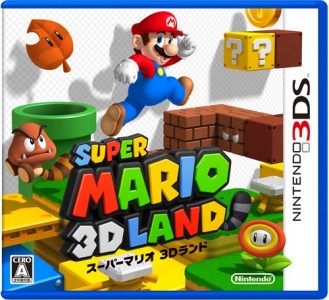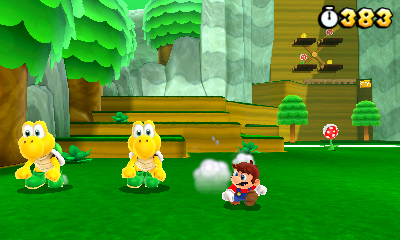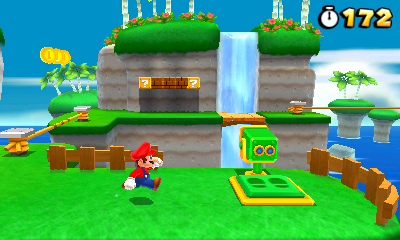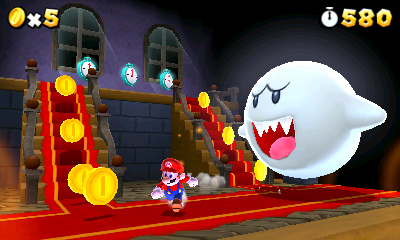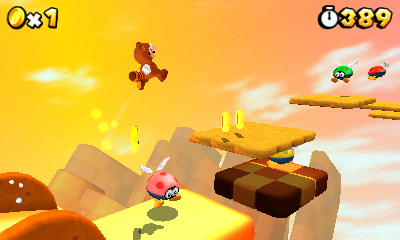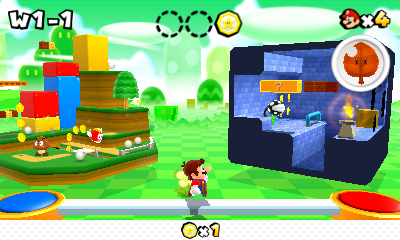Gamers are a passionate bunch, and will dispute everything. But if anyone ever tries to tell you that Super Mario 64 wasn’t a revolutionary game, I want you to Goomba-stomp them for me. Then run away with your hands over your ears.
Having played, finished and loved every single Mario platformer Nintendo has produced, I was stoked for the opportunity to get my hands on the newest adventure, which we all knew was gonna be awesome anyway. Despite the super clunky title, Super Mario 3D Land is likely to be responsible for shifting ludicrous numbers of 3DS systems leading up to Christmas.
If you’ve played a Mario game before – and I refuse to accept that anyone hasn’t – you already know the basics. But there’s more to it than what you expect.
As I started off by saying, Mario 64 was a revolution at the time; the switch to open-world 3D environments was unprecedented, and it sparked a new direction for the platform genre. But that was just one direction it could have taken. Around the same time, Crash Bandicoot emerged on the Playstation, rejecting the open world design in favour of linear levels that flow like a traditional platformer, while allowing for 3D movement.
Super Mario 3D Land follows Crash’s style, so in a way it feels to me like an alternate-reality Mario 64. While the 3D games were fantastic, I always found it hard to get into the flow in an open 3D environment. 3D Land reduces the freedom of exploration to create more structured, flowing gameplay. It mostly consists of 2D levels, sidescrolling left to right, with verticality as per usual, but now it allows movement towards and away from the screen. It’s a little hard to explain the significance, but it drastically changes the flow of play: levels usually follow a linear 2D path, allowing a small amount of 3D movement away from that axis. From time to time it will open up into a small open area, before narrowing back onto a single path or two. In this way it can retain the flow of a 2D platformer but allow multiple pathways, hidden areas and items to be accessible through the background/foreground.
This of course makes it perfect for Mario’s transition into the much-hyped third dimension; with gameplay literally going in and coming out of the screen, it looks and plays brilliantly in 3D. Bullet Bills fly towards the screen, there’s a new type of piranha plant that spits ink all over your view for a short time, and as Nintendo likes to spruik about, it actually is much easier to judge distance in 3D. I was sceptical about the idea, but my cynicism quickly melted away on having tried it. I hate dying in games because I overshoot an enemy or underestimate a gap. That frustration is all but gone, as your distance judgements feel strangely instinctive.
Another common gripe people have with 3D platformers is controlling the camera. Somehow, the industry has still not quite perfected the method of presenting game worlds in third person. There is no bigger frustration than dying because the camera suddenly swings in the opposite direction, or obscures the other side of the gap. Mario Galaxy tried to remedy this by wrenching the camera from the player’s control at crucial moments, pulling back to give the optimal view of the area and allowing players to focus on the actual task.
Super Mario 3D Land does this the whole time. Players are unburdened by camera controls; rather, your vantage point sits constantly at a perfect isometric angle, like someone’s pulled it up a bit from its usual perch in a 2D platformer. If Mario does happen to wander behind some scenery, as he’ll often be enticed to do for hidden items and areas, his silhouette will be visible through it, showing where he is and what he’s doing. Think Super Mario Sunshine, without the pointless iris-in effect. We’ll have to trust the designers to not put anything too dangerous back there.
Elements of most Mario platformers are apparent, but its strongest influence is Super Mario Bros. 3, arguably the pinnacle of the 2D Mario games. Each level is timed, and ends with a flagpole, complete with a set of stairs or a platform nearby to allow Mario to gain some extra points by aiming for the top. The last level of each world takes place on flying airships, and culminate in a boss battle with one of Bowser’s kids. And of course, Tanooki Mario returns.
Tanooki Mario, the raccoon suit you for some reason collect from a leaf, was iconic to SMB3, but hasn’t been seen since. Its reappearance was one of the first things the world learned about 3D Land, when it was revealed in the logo. Its use in the new game amounts to pretty much what it did in SMB3 – use it to whap your enemies or coin boxes, or flutter it during a fall to slow your descent. In practise, it unfortunately now has little effect on your falling speed, reducing its usefulness somewhat.
Its most useful power in its last appearance was flight. Get a decent run up, and you could effectively fly over the entire level. How this would work in a 3D environment has apparently stumped even the developers. It was announced recently that all Tanooki Flights have been grounded in Super Mario 3D Land, although it shouldn’t be unreasonable to expect that it still provides a longer or higher jump, with enough speed built up.
I was excited about this game by default, and my time with it has increased that excitement tenfold. Screw the third instalments of Battlefield, Killzone and Modern Warfare – this is my most anticipated title for the remainder of 2011. Nintendo never fail to creatively utilise their own hardware (eventually), and Super Mario 3D Land is probably the strongest reason yet to buy a 3DS.


